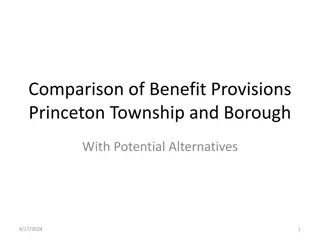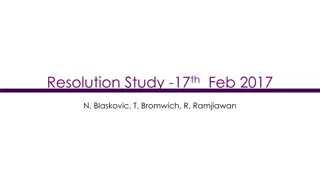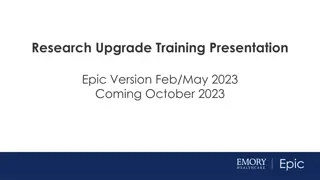
Innovative Approaches to Measuring Poverty and Social Valuation
Explore alternative methodologies for measuring poverty beyond traditional monetary approaches, including critiques of existing methods and the advocacy for feminist, pro-poor perspectives. Discover how a focus on social epistemology and participatory approaches can lead to more holistic and inclusive measurements of deprivation and well-being.
Download Presentation

Please find below an Image/Link to download the presentation.
The content on the website is provided AS IS for your information and personal use only. It may not be sold, licensed, or shared on other websites without obtaining consent from the author. If you encounter any issues during the download, it is possible that the publisher has removed the file from their server.
You are allowed to download the files provided on this website for personal or commercial use, subject to the condition that they are used lawfully. All files are the property of their respective owners.
The content on the website is provided AS IS for your information and personal use only. It may not be sold, licensed, or shared on other websites without obtaining consent from the author.
E N D
Presentation Transcript
Measuring Poverty: A Proposal Thomas Pogge and Scott Wisor February 28, 2014
Brief Critique of Existing Approaches Monetary Approaches Difficulty of making comparisons across space and time (purchasing power parities and consumer price indexes); Exclude important dimensions of deprivation (e.g., violence); Are insensitive to differences in needs and capacity to convert resources into achievement (e.g., variation of needs with age, gender, etc.); Typically are blind to intra-household inequalities.
Brief Critique II Subjective Approaches Problem of adaptation people may adjust their expectations and subjective evaluations to unjust or deprived circumstances and Expensive tastes the well-off may raise their gaze and thereby evaluate their lives as worse than they objectively appear to be. Mere personality explains some variance in subjective evaluations
Brief Critique III Multidimensional Approaches, like MPI which assesses health, education, standard of living at the household level, depends on existing data collection, and is not justified through a process of public reason. Its dual cut-off method fails to reveal degree of deprivations above and below the first cut-off, is insensitive to recorded deprivations above and below second cut-off, and ranks the just-deprived in more dimensions above those severely-deprived in fewer dimensions.
Feminist, Pro-Poor Approach Conceptual Analysis Rather than asking what our concept of poverty is, or what referent the term currently picks out in common usage, ask what our concept should be, given our aims and purposes. Requires normative reflection what values should the new conception reflect? What values are currently embedded in existing conceptions?
Feminist, Pro-Poor Approach II Social Epistemology Develop measures of social valuation through a process of public reason With those who have most experience of the phenomenon under investigation and most at stake in its measurement Generates a better measure by including more relevant information, and a more legitimate measure by producing it through a deliberative process
Feminist, Pro-Poor Approach III A Participatory Approach Local research teams in Angola, Fiji, Indonesia, Malawi, Mozambique, and the Philippines 3 sites in each country: urban, rural, marginalized (ethnic or religious minority, politically excluded, squatter settlement, etc.) Participant selection (adults only) aimed for a diversity of social locations
Qualitative Research I Research question: What is a just and justifiable, gender-sensitive measure of poverty? First phase of participatory research used 6 methods to investigate participants conceptions of poverty and related hardships, and the extent to which they were gendered: Key informant interviews; guided group discussions; brainstorming and ranking dimensions; poverty ladders; household mapping; and in-depth individual interviews.
Qualitative Research II Participants endorsed a conception that is multidimensional, reveals multiple levels of deprivation, is agent-relative and is context-sensitive Participants provided an initial list of candidate dimensions
Selecting Dimensions Participants were asked to assess the 25 candidate dimensions for inclusion in a multidimensional measure, evaluate each dimension for whether it is relevant for a life free from poverty and hardship, and rank dimensions, from 1 to 15, in terms of their importance in determining whether a life is free from poverty and hardship.
Selecting Dimensions II Candidate dimensions: (1) food; (2) water; (3) shelter; (4) health care; (5) education; (6) toilet; (7) clothing; (8) cooking fuel; (9) electricity; (10) family relationships; (11) personal care; (12) environment; (13) family planning; (14) information and communication; (15) freedom from violence; (16) location of services; (17) voice in the community; (18) free time; (19) freedom of movement; (20) participation in the community; (21) property rights; (22) freedom from debts/having assets/accessing credit; (23) sexual autonomy; (24) freedom from disruptive behavior; and (25) discretionary items.
Selecting Dimensions III Desiderata for inclusion Conceptual plausibility Moral importance Ease and reliability of measurement Suitable target for institutional response Comprehensive with minimal overlap Serves relevant values and purposes (e.g., reveals gender disparity)
Selected Dimensions (1) food; (2) water; (3) shelter; (4) health care; (5) education; (6) toilet; (7) clothing/ personal care; (8) energy/cooking fuel; (9) family relationships; (10) environment; (11) family planning; (12) freedom from violence; (13) voice in the community; (14) time use; (15) work status.
Designing the Measure I Indicator Selection Debate about the space of evaluation Reject happiness, subjective importance, and availability of the resource Accept access, use, and achievement 2 views: all are plausible bases for social evaluation OR there is only one plausible basis for social evaluation, but given practical constraints on measurement, indicators from multiple spaces are needed
Designing the Measure II 1 to 5 interval scale What is the main source of drinking water for members of your household? How long does it take to reach the water source from your dwelling (one way)? 1= No improved source, more than 30 minutes from home 2= No improved source, 30 minutes or less from home 3= Improved source, more than 30 minutes from home 4= Improved source, 30 minutes or less from home 5=Improved source in dwelling
Designing the Measure III How often do you have enough water to meet all your personal needs including drinking, washing, and cooking? (Always, Often, Sometimes, Rarely, Never) 1=Never 2=Rarely (1-2 days per week) 3=Sometimes (3-4 days per week) 4=Often (5-6 days per week) 5= Always
Designing the Measure IV Prioritarian Weighting Interval 1-2: 4 pts Interval 2-3: 3 pts Interval 3-4: 2 pts Interval 4-5: 1 pt
Designing the Measure V Dimension Weighting Top 5 dimensions given 3x weight Second 5 dimensions given 2x weight Third 5 dimensions given 1x weight
Designing the Measure Final step is to scale score on 0 to 100 (by dividing individual s score by maximum possible score) 90-100: Not deprived 80-89.9: Somewhat deprived 70-79.9: Deprived 60-69.9: Very Deprived <60: Extremely Deprived
Designing the Measure VI Two Axes of Achievement
Trial in the Philippines Nationally Representative Aimed to sample every member of the household to evaluate intra-household distribution of deprivation
Trial in the Philippines II Ease of administration Household and Individual Survey in under 90 minutes Individual Survey in under 60 minutes (often under 45) Of 1910 attempted interviews, 109 not completed Module with lowest response rate, violence, was 91% Inexpensive
Trial in the Philippines III Comparison with other measures
Trial in the Philippines IV Surprising Results
Trial in the Philippines V Explaining male underachievement True: Philippines scores well on other indices of gender equity, women outperform men in many dimensions in the Philippines, False: IDM asks for subjective evaluation of objective situations and women may overate their status in some dimensions, IDM treats men s and women s deprivations equally even in cases where it is likely worse for women (ex: violence and famil planning), more women interviewed than men, and possible that missing men are better off (that is, working away from home).
Future Research Refine dimensions and indicators Weighting (esp. participatory weights) Childhood deprivation Context sensitivity
Many thanks! Especially to the many people in this room who have provided us assistance along the way. thomas.pogge@yale.edu scott.l.wisor@gmail.com










